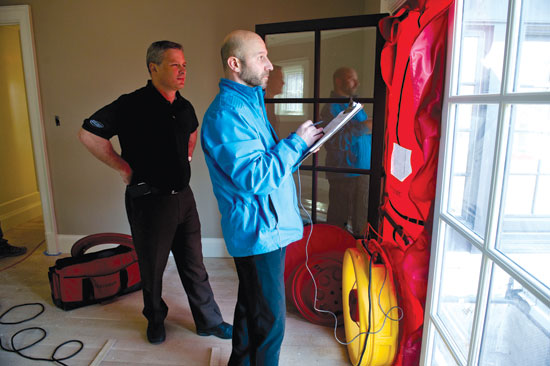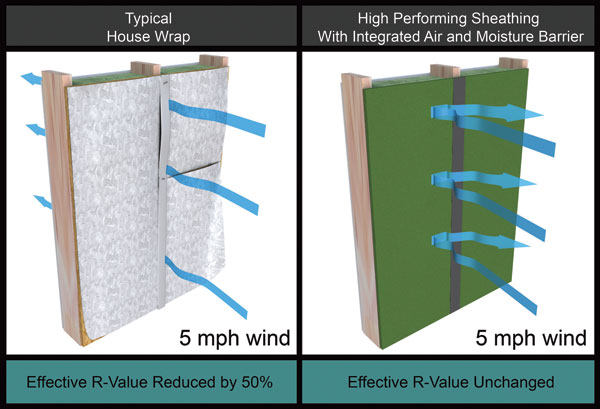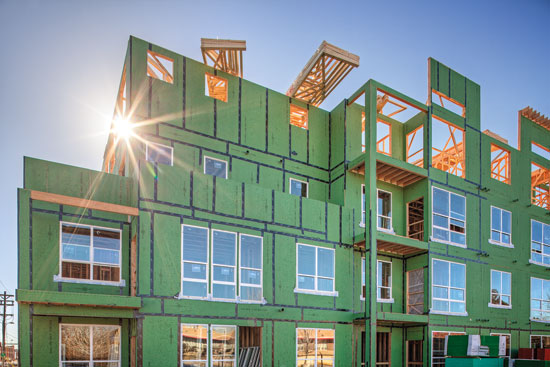Air, Water, and Moisture Management in Light Commercial Building Envelopes
Air Leakage and Thermal Performance
Next to stopping rain, the second most important job of a building enclosure is to stop air leaks, which can also compromise the durability of a structure. Uncontrolled air flow not only introduces moisture that can cause rot and mold, it can increase energy use and indoor air quality problems. Proper sealing between wall assembly components prevents unwanted air movement that washes through insulation and degrades the effective R-value. Without effectively sealing the building envelope, insulation cannot perform properly.
There are three different types of air flow: diffusion, in which air simply moves through the material and does not need a hole for entry; orifice flow, in which air comes in one area, follows the same paths, and moves out at the end of that path; and channel flow, in which air comes in one area, moves around, and exits in another area. With all of these types, there are plenty of areas and opportunities for air leakage, a scenario that requires an effective building envelope.
Building Envelope—A System of Many
The building envelope can be thought of as “a system of many.” Many variables exist that determine its performance. There are, for example, many components—exterior walls, foundations, roof, windows, and doors—as well as many penetrations in these components and many interfaces between them. Further, building envelope performance is impacted by many subsystems, including heating, cooling and ventilating equipment, plumbing and electrical systems, and many different types of activities of the building occupants. It is important to note, however, that no one product can control air leakage Air tightness is a function of the entire building envelope, and everything must work together in order to achieve effective air tightness. Even with a great air barrier system like a peel n' stick or taped wall joints, for example, air can still flow right through improperly flashed penetrations or leaky windows and doors.
The airtightness of a building envelope cannot be overestimated, however. A building's energy efficiency, occupant comfort, and sustainability quotient depend on it.

Image courtesy of Huber Engineered Woods
Blower door tests are the only satisfactory way to measure air tightness and highlight areas of heat loss.
Convective Loops
Today, the most commonly used insulation is still fiberglass batts, which offer a relatively low cost for the function it performs. As most insulation subcontractors are paid by the square foot, there is an incentive to install as much insulation as possible in a small amount of time, a scenario that leads to voids or gaps in the wall cavity that are not filled with insulation. With these voids, air can begin to travel around the insulation and sometimes within the insulation because its density is so low. If there is an effective air barrier on the outside of the building, this won't happen. The result is a reduction in the performance of the insulation or loss of R-value.
Consider the case of convection loops, which can form within wall assemblies from the warming and rising of air near the warm side of the assembly and the cooling and dropping of air near the cold side of the assembly. Uncontrolled air movement accelerates heat loss through convection. Air barriers prevent heat loss through convection.
Air flow often affects the performance of low-density fiber insulation. Air movement can compromise the thermal performance via wind washing, which occurs when wind enters and exits at different locations of the building envelope. The accompanying graph summarizes experimental measurements showing the effect of air infiltration on the installed R-value of the fiberglass insulation: about 50 percent of the insulation R-value is lost at 5mp wind speed if the insulation is not protected by an air barrier.

Image courtesy of Huber Engineered Woods
While in the event of a 5mph wind, with a typical house wrap the effective R-value is reduced by 50 percent, though it remains unchanged with high performing sheathing.
Air Barrier Systems—Preventing Air Flow Through the Wall
Air sealing the building envelope is one of the most critical features of an energy-efficient building. Preventing unwanted air flow, an air barrier system is composed of materials that form and seal floors, walls, and ceilings to prevent unwanted air movement. To be effective, the system must be continuous with no holes, openings, or penetrations and resistant to air pressure differentials. Durability, strength, and impermeability are also key factors as well as sufficient stiffness to allow adhesion. To be effective air barrier system components—including panels and tape—must have passed the air tightness requirements as set forth in the stringent air barrier assembly testing standard (ASTM E 2357) by the Air Barrier Association of America (ABAA). The effectiveness of tape and tape and flashing adhesion, while of prime importance, is often discounted in articles on air barriers. As those in the industry like to joke, tapes should be used to create an air barrier that will “peel n' stick, not stick n' peel.”
Testing for Air Leaks
Tests have been developed to measure how effectively an air barrier system prevents unwanted airflow. Professional energy auditors use blower door tests to help determine a structure's airtightness—these tests are the only satisfactory way to measure air tightness and highlight areas of heat loss.
A blower door is a powerful fan that mounts into the frame of an exterior door. The fan pulls air out of the house, lowering the air pressure inside. The higher outside air pressure then flows in through all unsealed cracks and openings. Air leaking into the house from outside can be detected using a smoke pencil. According to the U.S. Department of Energy, there are two types of blower doors: calibrated and uncalibrated. Auditors should use a calibrated door, which has several gauges that measure the amount of air pulled out of the structure by the fan. Uncalibrated blower doors can only locate leaks in buildings, and they offer no method for determining the overall tightness of a building. On the other hand, the calibrated blower door's data allow the auditor to quantify the amount of air leakage and the effectiveness of any air-sealing job.
Energy auditors may also use thermography, or infrared scanning, to detect thermal defects and air leakage in building envelopes in conjunction with a blower door test. The accompanying illustration shows thermal, or infrared, image that indicates air leakage at the bottom of a wall and through an electrical outlet.
Ways to Improve Air Tightness
Architects have various strategies to improve air tightness of the building envelope.
Caulk and foam gaps and seams. Probably the most common products for creating an airtight barrier are tapes, gaskets, caulks, and spray foam materials. Caulking is a simple, effective air-sealing technique that is generally used for cracks and openings between stationary building components such as around door and window frames. Special care needs to be taken when using spray foams, as some expand more than others and some can exert significant pressure on the surrounding structure during expansion.
Building wraps. Provided all seams, edges and details are sealed, and that it is caulked at the bottom, building wraps can help decrease air leakage. A good building wrap material must provide waterproof protection and have a high moisture vapor transmission rate to be considered effective. Some newer building wrap designs are susceptible to ripping or tearing and must be handled carefully. Intended to be installed over the sheathing and behind the siding, whether the siding is brick, vinyl, concrete or any other material, building wrap will stop or reduce moisture infiltration and reduce the water condensation or mold problems getting into the studs or wall cavity.
Peel n' stick air barriers. Squares or rectangles of roofing underlayment with adhesive backing that is peeled off and the underlayment pressed into place are considered a superior option for ice and water barriers. Peel-n-stick underlayments can be a first layer on potentially problematic areas, or installed on the entire roof if it is low slope or flat. However, the adhesive is temperature-sensitive until securely bonded to a dry surface, and many of the materials are slippery, and unsafe to walk on directly after application.
Taped wall sheathing panels. All-in-one sheathing panels are a good choice for improving air tightness. The taped sheathing panels form a continuous protective air barrier, significantly reducing air leakage through walls or roofs and lowering air changes per hour. This helps optimize R-value, save energy, and meet increasingly stringent performance requirements of energy codes and green building programs.

Photo courtesy of Huber Engineered Woods
All-in-one sheathing panels are a good choice for improving air tightness.









